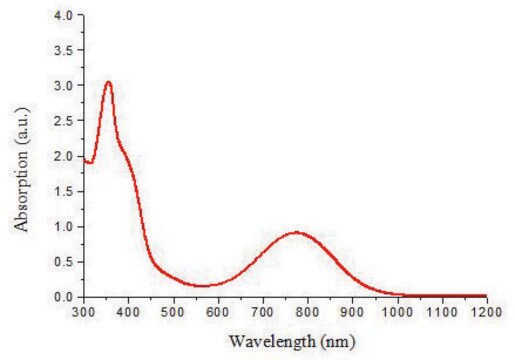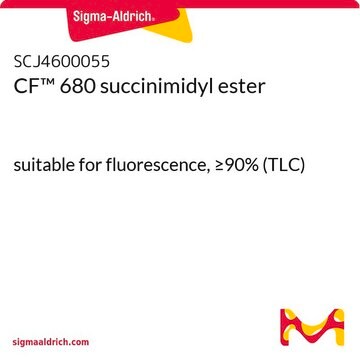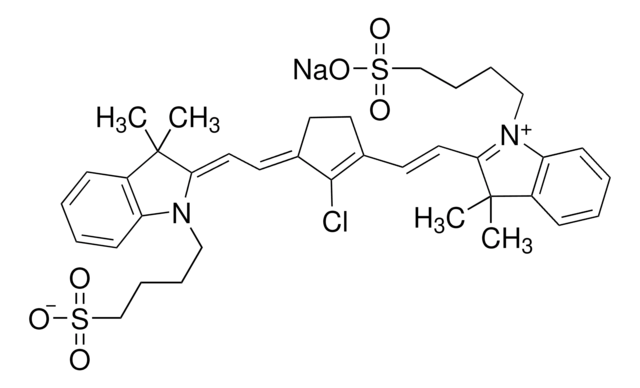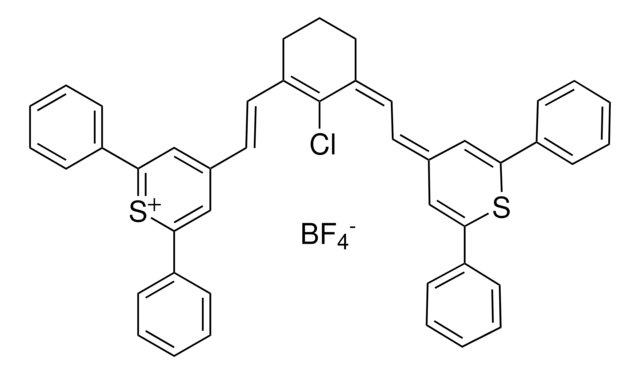91394
Atto 740
BioReagent, suitable for fluorescence, ≥98.0% (HPCE)
Sign Into View Organizational & Contract Pricing
All Photos(1)
About This Item
MDL number:
UNSPSC Code:
12352200
Recommended Products
product line
BioReagent
Assay
≥98.0% (HPCE)
form
powder
manufacturer/tradename
ATTO-TEC GmbH
fluorescence
λex 740 nm; λem 764 nm in 0.1 M phosphate pH 7.0
suitability
suitable for fluorescence
storage temp.
−20°C
General description
Atto 740 is a new infrared label with high molecular absorption (120.000) and sufficient stoke′s shift between excitation and emission maximum. Atto 740 is characterized by high photostability and thermal stability. It is moderately soluble in water. ATTO 740 is a pH sensitive product. While practically stable at pH 7.4 (PBS Buffer), it slowly degrades at higher pH. After 7 hours at pH 8.25 (0.2 M sodiumbicarbonate buffer) 85% of the dye is retained.
Application
QY=10%, Tfl 0.6 ns
Storage Class Code
13 - Non Combustible Solids
WGK
WGK 3
Flash Point(F)
Not applicable
Flash Point(C)
Not applicable
Personal Protective Equipment
dust mask type N95 (US), Eyeshields, Gloves
Choose from one of the most recent versions:
Already Own This Product?
Find documentation for the products that you have recently purchased in the Document Library.
E Shane Price et al.
The journal of physical chemistry. B, 115(29), 9320-9326 (2011-06-22)
Fluorescence correlation spectroscopy (FCS) can be coupled with Förster resonance energy transfer (FRET) to detect intramolecular dynamics of proteins on the microsecond time scale. Here we describe application of FRET-FCS to detect fluctuations within the N-terminal and C-terminal domains of
Tip-enhanced single molecule fluorescence near-field microscopy in aqueous environment.
Frey, H.G., et al.
Applied Physics Letters, 94, 241116-241116 (2009)
Sez-Jade Chen et al.
Journal of biophotonics, 12(3), e201800185-e201800185 (2018-11-14)
We introduce a simple new approach for time-resolved multiplexed analysis of complex systems using near-infrared (NIR) dyes, applicable to in vitro and in vivo studies. We show that fast and precise in vitro quantification of NIR fluorophores' short (subnanosecond) lifetime
Scott B Raymond et al.
Journal of biomedical optics, 15(4), 046011-046011 (2010-08-31)
Near-infrared (NIR) fluorescence tomography of multiple fluorophores has previously been limited by the bandwidth of the NIR spectral regime and the broad emission spectra of most NIR fluorophores. We describe in vivo tomography of three spectrally overlapping fluorophores using fluorescence
Zhiliang Cheng et al.
Bioconjugate chemistry, 22(10), 2021-2029 (2011-09-09)
Block copolymer-based vesicles have recently garnered a great deal of interest as nanoplatforms for drug delivery and molecular imaging applications due to their unique structural properties. These nanovesicles have been shown to direct their cargo to disease sites either through
Our team of scientists has experience in all areas of research including Life Science, Material Science, Chemical Synthesis, Chromatography, Analytical and many others.
Contact Technical Service







